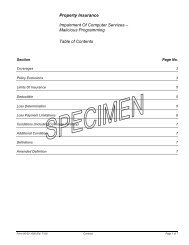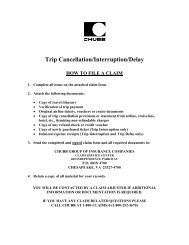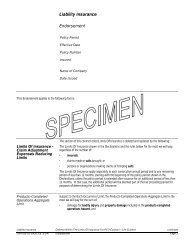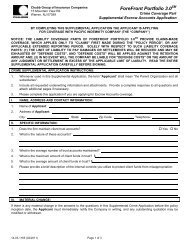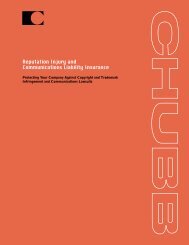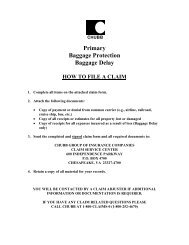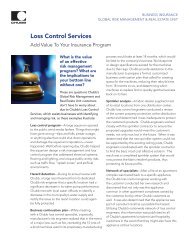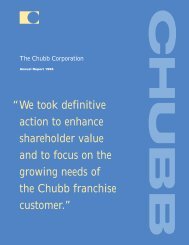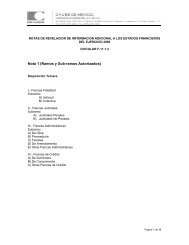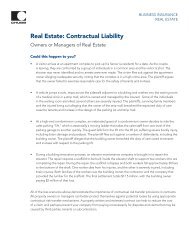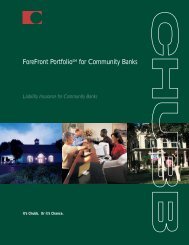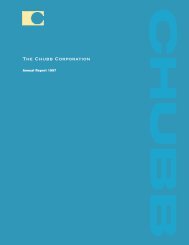Annual Report 2005 - Chubb Group of Insurance Companies
Annual Report 2005 - Chubb Group of Insurance Companies
Annual Report 2005 - Chubb Group of Insurance Companies
You also want an ePaper? Increase the reach of your titles
YUMPU automatically turns print PDFs into web optimized ePapers that Google loves.
<strong>of</strong> properties where asbestos was present. Generally,<br />
these insureds are named defendants on a regional rather<br />
than a nationwide basis. As the Ñnancial resources <strong>of</strong><br />
traditional asbestos defendants have been depleted, plaintiÅs<br />
are targeting these viable peripheral parties with<br />
greater frequency and, in many cases, for larger awards.<br />
Asbestos claims against the major manufacturers, dis-<br />
tributors or installers <strong>of</strong> asbestos products were<br />
presented under the products liability section <strong>of</strong> primary<br />
general liability policies as well as under excess liability<br />
policies, both <strong>of</strong> which typically had aggregate limits that<br />
capped an insurer's exposure. In recent years, a number<br />
<strong>of</strong> asbestos claims by insureds are being presented as<br />
""non-products'' claims, such as those by installers <strong>of</strong><br />
asbestos products and by property owners or operators<br />
who allegedly had asbestos on their property, under the<br />
premises or operations section <strong>of</strong> primary general liability<br />
policies. Unlike products exposures, these non-products<br />
exposures typically had no aggregate limits on coverage,<br />
creating potentially greater exposure. Further, in an effort<br />
to seek additional insurance coverage, some insureds<br />
with installation activities who have substantially eroded<br />
their products coverage are presenting new asbestos<br />
claims as non-products operations claims or attempting<br />
to reclassify previously settled products claims as non-<br />
products claims to restore a portion <strong>of</strong> previously exhausted<br />
products aggregate limits. It is diÇcult to predict<br />
whether insureds will be successful in asserting claims<br />
under non-products coverage or whether insurers will be<br />
successful in asserting additional defenses. Therefore, the<br />
future impact <strong>of</strong> such eÅorts on insurers is uncertain.<br />
In establishing asbestos reserves, the exposure<br />
presented by each insured is evaluated. As part <strong>of</strong> this<br />
evaluation, consideration is given to a variety <strong>of</strong> factors<br />
including the available insurance coverage; limits and<br />
deductibles; the jurisdictions involved; past settlement<br />
values <strong>of</strong> similar claims; the potential role <strong>of</strong> other<br />
insurance, particularly underlying coverage below excess<br />
liability policies; potential bankruptcy impact; and applicable<br />
coverage defenses, including asbestos exclusions.<br />
SigniÑcant uncertainty remains as to the ultimate liabil-<br />
ity <strong>of</strong> the P&C <strong>Group</strong> relating to asbestos related claims.<br />
This uncertainty is due to several factors including the<br />
long latency period between asbestos exposure and dis-<br />
ease manifestation and the resulting potential for involve-<br />
ment <strong>of</strong> multiple policy periods for individual claims;<br />
plaintiÅs' increased focus on peripheral defendants; the<br />
increase in the volume <strong>of</strong> claims by unimpaired plaintiÅs<br />
and the extent to which they can be precluded from<br />
making claims; the eÅorts by insureds to obtain coverage<br />
not subject to aggregate limits; the number <strong>of</strong> insureds<br />
seeking bankruptcy protection as a result <strong>of</strong> asbestos<br />
related liabilities and the impact <strong>of</strong> prepackaged bankruptcies;<br />
the ability <strong>of</strong> claimants to bring a claim in a state<br />
in which they have no residency or exposure; inconsistent<br />
court decisions and diverging legal interpretations;<br />
and the possibility, however remote, <strong>of</strong> federal legislation<br />
that would address the asbestos problem. These signiÑcant<br />
uncertainties are not likely to be resolved deÑnitively<br />
in the near future.<br />
<strong>Insurance</strong> losses and loss expenses <strong>of</strong> the P&C <strong>Group</strong><br />
included $35 million, $75 million and $250 million in<br />
<strong>2005</strong>, 2004 and 2003, respectively, related to asbestos<br />
claims.<br />
Toxic waste claims relate primarily to pollution and<br />
related cleanup costs. The P&C <strong>Group</strong>'s insureds have<br />
two potential areas <strong>of</strong> exposure: hazardous waste dump<br />
sites and pollution at the insured site primarily from<br />
underground storage tanks and manufacturing processes.<br />
Under the federal ""Superfund'' law and similar state<br />
statutes, when potentially responsible parties (PRPs) fail<br />
to handle the clean-up at a hazardous waste site, regula-<br />
tors have the work done and then attempt to establish<br />
legal liability against the PRPs. Most sites have multiple<br />
PRPs.<br />
Most PRPs named to date are parties who have been<br />
generators, transporters, past or present landowners or<br />
past or present site operators. The PRPs disposed <strong>of</strong><br />
toxic materials at a waste dump site or transported the<br />
materials to the site. <strong>Insurance</strong> policies issued to PRPs<br />
were not intended to cover the clean-up costs <strong>of</strong> pollu-<br />
tion and, in many cases, did not intend to cover the<br />
pollution itself.<br />
As the costs <strong>of</strong> environmental clean-up became substantial,<br />
PRPs and others increasingly Ñled claims with<br />
their insurance carriers. Litigation against insurers ex-<br />
tends to issues <strong>of</strong> liability, coverage and other policy<br />
provisions.<br />
There is substantial uncertainty involved in estimating<br />
the P&C <strong>Group</strong>'s liabilities related to these claims. First,<br />
the liabilities <strong>of</strong> the claimants are extremely diÇcult to<br />
estimate. At any given waste site, the allocation <strong>of</strong><br />
remediation costs among governmental authorities and<br />
the PRPs varies greatly depending on a variety <strong>of</strong> factors.<br />
Second, diÅerent courts have addressed liability and<br />
coverage issues regarding pollution claims and have<br />
reached inconsistent conclusions in their interpretation<br />
<strong>of</strong> several issues. These signiÑcant uncertainties are not<br />
likely to be resolved deÑnitively in the near future.<br />
Uncertainties also remain as to the Superfund law<br />
itself. Superfund's taxing authority expired on December<br />
31, 1995 and has not been re-enacted. Federal<br />
legislation appears to be at a standstill. At this time, it is<br />
not possible to predict the direction that any reforms<br />
may take, when they may occur or the eÅect that any<br />
changes may have on the insurance industry.<br />
Without federal movement on Superfund reform, the<br />
enforcement <strong>of</strong> Superfund liability is shifting to the<br />
states. States are being forced to reconsider state-level<br />
cleanup statutes and regulations. As individual states<br />
move forward, the potential for conÖicting state regula-<br />
tion becomes greater. In a few states, cases have been<br />
brought against insureds or directly against insurance<br />
companies for environmental pollution and natural re-<br />
sources damages. To date, only a few natural resources<br />
claims have been Ñled and they are being vigorously<br />
defended. SigniÑcant uncertainty remains as to the cost<br />
<strong>of</strong> remediating the state sites. Because <strong>of</strong> the large num-<br />
ber <strong>of</strong> state sites, such sites could prove even more costly<br />
in the aggregate than Superfund sites.<br />
F-14



